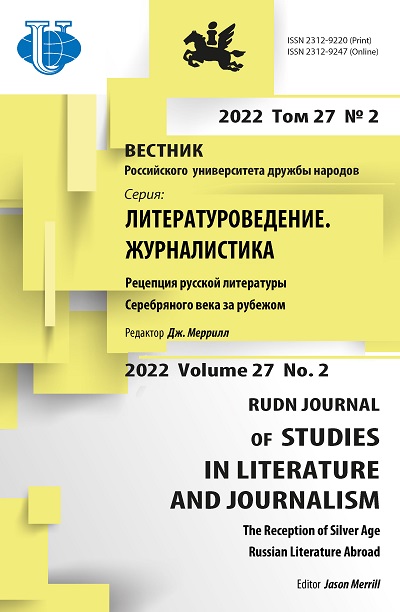Structural and Semiotic Features of the Virtual Narrative in Immersive RIA.Lab Projects
- Authors: Samartsev O.R.1, Latenkova V.M.2, Sleptsov N.A.3
-
Affiliations:
- Ulyanovsk State University
- Media Industry Academy
- Peoples’ Friendship University of Russia (RUDN University)
- Issue: Vol 27, No 2 (2022): THE RECEPTION OF SILVER AGE RUSSIAN LITERATURE ABROAD
- Pages: 414-424
- Section: JOURNALISM
- URL: https://journals.rudn.ru/literary-criticism/article/view/31466
- DOI: https://doi.org/10.22363/2312-9220-2022-27-2-414-424
- ID: 31466
Cite item
Full Text
Abstract
The article examines the semiotic features of the virtual narrative in the projects of RIA.Lab platform of the leading Russian news agency “Russia Today”. The aim is to analyze the structural, linguistic and iconic elements of the virtual narrative in relation to the projects of immersive journalism, highlighting their features, taking into account the multimodal nature of virtual reality and the simulative aspect of the sign system of immersive works. Virtual space is not only a narrative environment with special topos, chronotope and other narrative elements, but is itself a semiotic element, participating in the process of semiosis, the space of virtual “language game”. The thesis is put forward that VR, being an element of the multimodal information and communication universe, contains in its structure other modalities (TV, radio, cinema, print formats), and is multidimensional, a kind of “modus in modus”. The thesis on the priority of the modeling approach to the creation of immersive mass-media content over the simulative one and the necessity of observing the balance between modeling and simulation in immersive journalism are discussed. The specifics of conventional conditions of interpretation of simulacra signs in virtual space, which depend on the degree of their identity to the signs of real reality and the “rules of the virtual game”, set by the authors, are outlined. The directions of increasing the pragmatic efficiency of virtual narrative through the variability of its affords, the use of emphases, haptics (tactile experience) and other means of VR are outlined.
About the authors
Oleg R. Samartsev
Ulyanovsk State University
Email: olegsamar@rambler.ru
ORCID iD: 0000-0003-1236-4410
Doctor of Philological Sciences, Professor of Journalism Department
42 Leo Tolstoy St, Ulyanovsk, 432017, Russian FederationVera M. Latenkova
Media Industry Academy
Email: latenkova@gmail.com
ORCID iD: 0000-0003-2488-4712
Candidate of Philological Sciences, Scientific Secretary
105 Oktyabrskaya St, bldg 2, Moscow, 127562, Russian FederationNikolai A. Sleptsov
Peoples’ Friendship University of Russia (RUDN University)
Author for correspondence.
Email: nicksleptsov@gmail.com
ORCID iD: 0000-0002-3447-8008
Post-Graduate Student, Department of Mass Communications
10 Miklukho-Maklaya St, bldg 2, Moscow, 117198, Russian FederationReferences
- Baudrillard, J. (2017). Simulacra and simulations. Translated from French. Moscow: POSTUM Publishing House. (In Russ.)
- Baudrillard, J. (2020). The Consumer Society. Translated from the French. Moscow: AST Publishing House. (In Russ.)
- Buerkle, R. (2008). Of worlds and avatars: a playercentric approach to videogames. (Dissertation). University of Southern California Digital Library. Retrieved from https://digitallibrary.usc.edu/asset-management/2A3BF1FCF2QV
- Cowger, T., & Tritz, J. (2021). Narrative Analysis Research: A Tool for Extension Educators. The Journal of Extension, 57(6), article 1. Retrieved from https://tigerprints.clemson.edu/joe/vol57/iss6/1
- Dzyaloshinsky, I.M. (2021). Digital communication services in the era of the formation of artificial intelligence. Journalist. Social communications, 41(1), 11–33. (In Russ.)
- Juul, J. (2015). Games Telling Stories? A Brief Note on Games and Naratives. LOGOS Philosophical and Literary Journal, 25(1–103), 61–78.
- Kress, G. (2016). Social semiotics and the challenges of multimodality. Political science RU, (3), 77–100. (In Russ.)
- Laikova, A.A., & Logacheva, A.S. (2016). Affordance in web interface. Actual problems of aviation and astronautics, 2(12), 748–750. (In Russ.)
- Madianou, M., & Miller, D. (2018). Polymedia: Towards a new theory of digital media in interpersonal communication. Monitoring of Public Opinion: Economic and Social Changes, 143(1), 334–356. (In Russ.) https://doi.org/10.14515/monitoring.2018.1.17
- Novikova, A.A., & Kiriya, I.V. (2018). Aesthetics of immersion: Creativity of the journalist in multimedia and transmedia projects. Vestnik of Saint Petersburg University. Language and Literature, 15(2), 276–288. (In Russ.) https://doi.org/10.21638/11701/spbu09.2018.210.
- Penzina, A.I., & Parkhitko, N.P. (2019). Analysis of the concept of Jean Baudrillard in the formation of hyper- and virtual reality in the media. Sociology, (1), 178–181. (In Russ.)
- Samoilova, E.O., & Shaev, Y.M. (2016). Computer games as a virtual narrative. Historical, philosophical, political and legal sciences, cultural studies and art history. Questions of theory and practice, 64(2), 171–173. (In Russ.)
- Shitenko, J.O. (2015). Newsgames as a new phenomenon of journalism. Bulletin of Chelyabinsk State University, 360(5). Philology. Art History, 94, 350–356. (In Russ.)
- Sun, Y., & Suthers, D. (2021). Cultural Affordances and Social Media. Proceedings of the 54th Hawaii International Conference on System Sciences, 3017–3026.
- Uskali, T., Gynnild, A., Jones, S., & Sirkkunen, E. (2021). Immersive Journalism as Storytelling. Ethics, Production, and Design. London; New York: Routledge, Taylor & Francis Group.
- Utkin, A., & Pokrovskaya, N. (2020). White Mirror: A textbook on interactive storytelling in cinema, VR and immersive theater. Moscow: Alpina Publ. (In Russ.)
- Vyas, D., Chisalita, C., & Van der Veer, G.C. (2006). Affordance in Interaction. Proceedings of the 13th European Conference on Cognitive Ergonomics, 92–99. https://doi.org/10.1145/1274892.1274907.
- Zakharova, S.V. (2009). Virtual reality in the senses and meanings of language. Bulletin of Chelyabinsk State University. Philosophy. Sociology. Culturology, 13(29), 5–11. (In Russ.)
- Zamkov, A.V., Krasheninnikova, M.A., Lukina, M.M., & Tsynareva, N.A. (2017). Immersive journalism: approaches to theory and problems of education. Modern Information Technologies and IT-Education, 13(1), 166–172. (In Russ.)
Supplementary files















